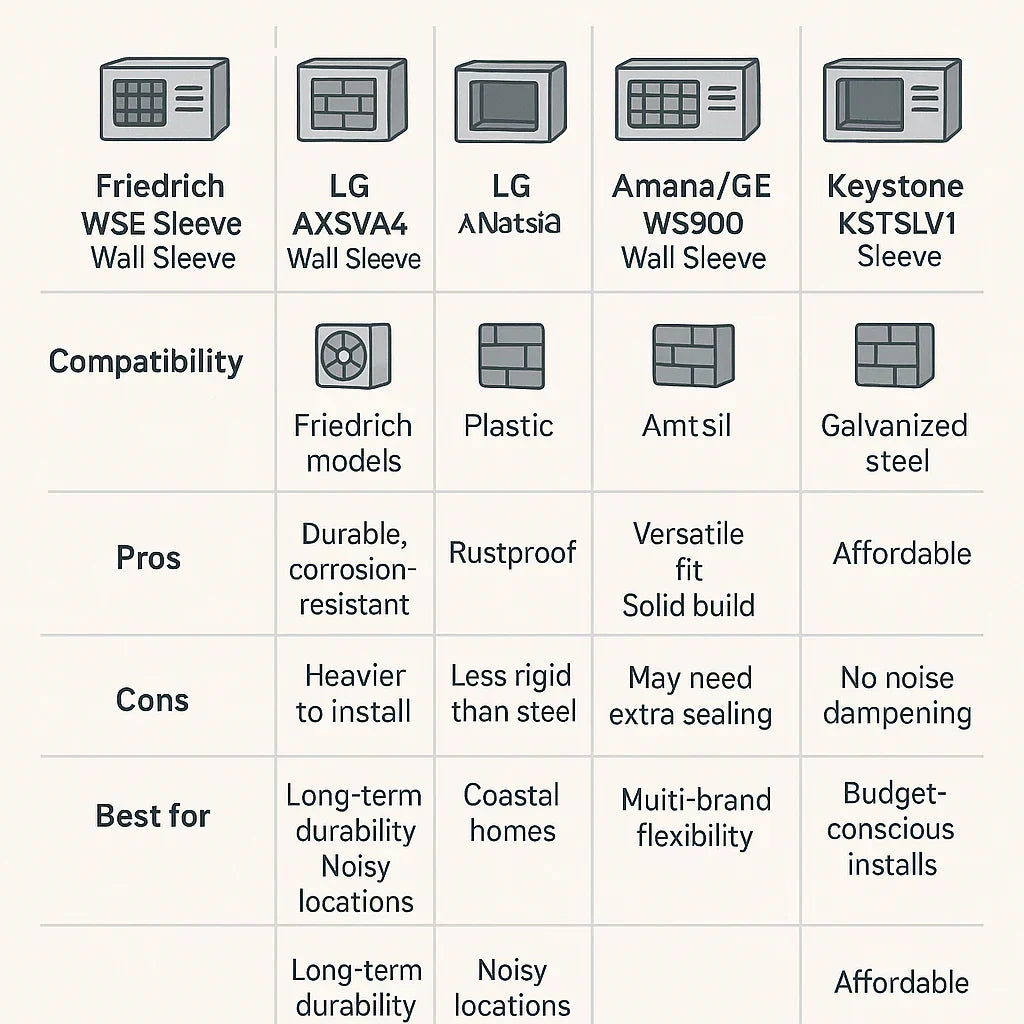☕ Introduction — Why the Wall Sleeve Isn’t Just an Afterthought
When I first started shopping for a through-the-wall heat pump, the salesperson asked if I needed a wall sleeve. I almost said, “Nah, I’ll figure it out.” Big mistake.
A buddy of mine skipped getting the proper sleeve for his new unit and “made do” with the one from an old AC. Six months later, the misfit sleeve had gaps that let rainwater in. The inside wall rotted, mold set in, and his unit was louder than a lawnmower. He spent more fixing that than he did on the heat pump.
A wall sleeve is not just a metal box you shove your unit into. It’s the structural frame, weather barrier, and noise damper for your system. Choose wrong, and you’ll be paying for it in noise, leaks, and efficiency loss.
Best Through The Wall Heat Pumps
🧱 1. What a Wall Sleeve Does — More Than Meets the Eye
A quality wall sleeve for a through-the-wall heat pump:
-
Supports the unit — Keeps your 70–120 lb system stable and secure in the wall.
-
Protects from weather — Prevents rain, wind, snow, and pests from sneaking in around the unit.
-
Directs drainage — Has a slight pitch to drain condensation outdoors.
-
Reduces vibration and noise — Foam seals and dampers keep the hum down.
-
Improves efficiency — Proper insulation prevents air leaks.
Think of it as the foundation of your heat pump install. Weak foundation = weak system.
📏 2. Compatibility — Getting the Fit Right
Heat pump wall sleeves are not one-size-fits-all. They vary in size, mounting method, and drainage design.
Check Brand-Specific Requirements
Most manufacturers design their units to fit specific sleeves:
-
Friedrich units typically use WSE or USC sleeves.
-
LG wall units fit the AXSVA4 series sleeves.
-
Amana/GE share some sleeve compatibility but not always.
Pro Tip: Always check your unit’s manual for the exact compatible sleeve model.
Reference: ENERGY STAR’s product finder tool for compatibility (EnergyStar.gov).
Universal vs. OEM Sleeves
-
OEM sleeves: Perfect fit, matched drainage, guaranteed compatibility.
-
Universal sleeves: May fit multiple brands, but you’ll need to double-check dimensions and drainage direction.
🧱 3. Material Choices — Which Lasts Longer?
Wall sleeves come in steel, aluminum, and heavy-duty plastic.
| Material | Pros | Cons |
|---|---|---|
| Galvanized Steel | Strong, long-lasting, excellent weather resistance | Heavier, may cost more |
| Aluminum | Lightweight, rust-resistant | Can transmit more vibration/noise |
| Heavy-Duty Plastic | Won’t rust, light, easy to handle | Less rigid than metal, can warp in extreme heat |
For coastal areas, I lean toward plastic or aluminum to avoid corrosion. For inland installs, steel is my go-to.
📐 4. Sizing & Fit — Avoiding Air Leaks and Rattles
Most sleeves follow standard dimensions: 26" width × 15.5" height × 16–20" depth. But depth is where you can run into trouble—walls vary.
Steps to Measure:
-
Measure wall thickness from inside drywall to exterior siding/brick.
-
Compare to sleeve depth—choose one slightly deeper, not shorter.
-
Use foam gaskets or weatherstripping to fill small gaps.
Pro Tip: An undersized sleeve invites drafts, noise, and reduced efficiency.
🔇 5. Noise Reduction Strategies
A wall sleeve can make your heat pump quiet or annoyingly loud.
Look for sleeves with:
-
Foam-lined interiors to dampen vibration.
-
Gasketed front edges to seal against the unit faceplate.
-
Solid mounting flanges to reduce rattle.
For extreme noise control, add acoustic insulation panels inside the sleeve (manufacturer-approved only).
Reference: Noise control basics from HVAC.com (HVAC.com).
🏆 6. Top Wall Sleeve Options on the Market
1. Friedrich WSE Wall Sleeve
-
Material: Heavy-duty galvanized steel
-
Pros: Durable, corrosion-resistant, foam lining for noise reduction
-
Cons: Heavier to install solo
-
Best for: Long-term durability, noisy locations
2. LG AXSVA4 Wall Sleeve
-
Material: High-grade plastic
-
Pros: Rustproof, light, easy to handle, coastal-friendly
-
Cons: Slightly less rigid than steel
-
Best for: Coastal homes, DIY installs
3. Amana/GE WS900 Wall Sleeve
-
Material: Steel with baked enamel finish
-
Pros: Fits multiple brand models, solid build
-
Cons: May need extra foam for best seal
-
Best for: Multi-brand flexibility
4. Keystone KSTSLV1
-
Material: Galvanized steel
-
Pros: Affordable, weatherproof
-
Cons: No built-in noise dampers
-
Best for: Budget-conscious installs
🧰 7. Installation Tips for a Perfect Fit
A sleeve that’s poorly installed will cancel out all its benefits.
Tips:
-
Pitch the sleeve slightly downward toward the outside for drainage.
-
Seal both inside and outside with foam and exterior caulk.
-
Follow brand’s foam kit instructions—they’re not optional.
-
If installing in masonry, use corrosion-resistant fasteners.
Reference: Cutting and prep tips from This Old House (ThisOldHouse.com).
🛠 8. Maintenance & Replacement
Wall sleeves last years, but not forever.
Inspect yearly for:
-
Rust or corrosion (steel/aluminum).
-
Cracks or warping (plastic).
-
Loose mounting or shifted pitch.
-
Foam seals deteriorating.
Replace foam seals every 3–5 years for top efficiency.
✅ Jake’s Final Take
Don’t skimp here. Spending $150–$200 on the right wall sleeve once beats spending $500+ fixing leaks, rot, or noise issues later.
Jake’s Sleeve Buying Checklist:
-
Match the sleeve to your unit’s brand/model.
-
Choose the right material for your climate.
-
Measure wall depth—don’t guess.
-
Pick noise-dampening features if you value quiet.
-
Install with proper pitch and sealing.
External References in This Guide:
In the Next Topic we will know more about: Through-the-Wall vs. Window Heat Pumps: Which Should You Choose?







